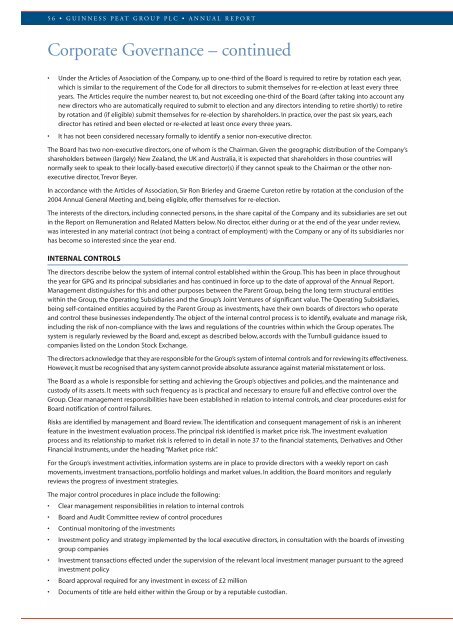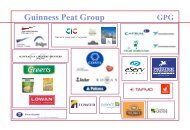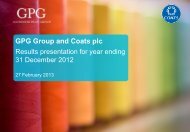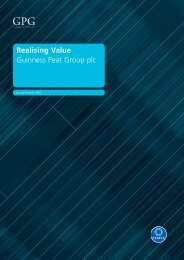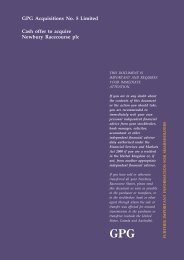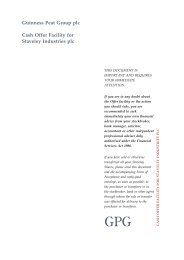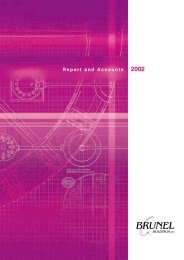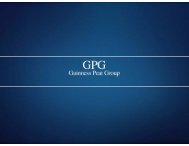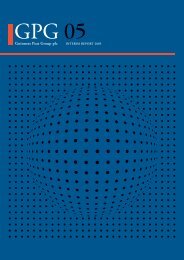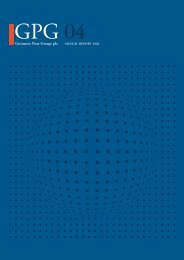GPG Report & Accounts 2003 - Guinness Peat Group plc
GPG Report & Accounts 2003 - Guinness Peat Group plc
GPG Report & Accounts 2003 - Guinness Peat Group plc
- No tags were found...
Create successful ePaper yourself
Turn your PDF publications into a flip-book with our unique Google optimized e-Paper software.
56 • GUINNESS PEAT GROUP PLC • ANNUAL REPORTCorporate Governance – continued• Under the Articles of Association of the Company, up to one-third of the Board is required to retire by rotation each year,which is similar to the requirement of the Code for all directors to submit themselves for re-election at least every threeyears. The Articles require the number nearest to, but not exceeding one-third of the Board (after taking into account anynew directors who are automatically required to submit to election and any directors intending to retire shortly) to retireby rotation and (if eligible) submit themselves for re-election by shareholders. In practice, over the past six years, eachdirector has retired and been elected or re-elected at least once every three years.• It has not been considered necessary formally to identify a senior non-executive director.The Board has two non-executive directors, one of whom is the Chairman. Given the geographic distribution of the Company’sshareholders between (largely) New Zealand, the UK and Australia, it is expected that shareholders in those countries willnormally seek to speak to their locally-based executive director(s) if they cannot speak to the Chairman or the other nonexecutivedirector, Trevor Beyer.In accordance with the Articles of Association, Sir Ron Brierley and Graeme Cureton retire by rotation at the conclusion of the2004 Annual General Meeting and, being eligible, offer themselves for re-election.The interests of the directors, including connected persons, in the share capital of the Company and its subsidiaries are set outin the <strong>Report</strong> on Remuneration and Related Matters below. No director, either during or at the end of the year under review,was interested in any material contract (not being a contract of employment) with the Company or any of its subsidiaries norhas become so interested since the year end.INTERNAL CONTROLSThe directors describe below the system of internal control established within the <strong>Group</strong>. This has been in place throughoutthe year for <strong>GPG</strong> and its principal subsidiaries and has continued in force up to the date of approval of the Annual <strong>Report</strong>.Management distinguishes for this and other purposes between the Parent <strong>Group</strong>, being the long term structural entitieswithin the <strong>Group</strong>, the Operating Subsidiaries and the <strong>Group</strong>’s Joint Ventures of significant value. The Operating Subsidiaries,being self-contained entities acquired by the Parent <strong>Group</strong> as investments, have their own boards of directors who operateand control these businesses independently. The object of the internal control process is to identify, evaluate and manage risk,including the risk of non-compliance with the laws and regulations of the countries within which the <strong>Group</strong> operates. Thesystem is regularly reviewed by the Board and, except as described below, accords with the Turnbull guidance issued tocompanies listed on the London Stock Exchange.The directors acknowledge that they are responsible for the <strong>Group</strong>’s system of internal controls and for reviewing its effectiveness.However,it must be recognised that any system cannot provide absolute assurance against material misstatement or loss.The Board as a whole is responsible for setting and achieving the <strong>Group</strong>’s objectives and policies, and the maintenance andcustody of its assets. It meets with such frequency as is practical and necessary to ensure full and effective control over the<strong>Group</strong>. Clear management responsibilities have been established in relation to internal controls, and clear procedures exist forBoard notification of control failures.Risks are identified by management and Board review. The identification and consequent management of risk is an inherentfeature in the investment evaluation process. The principal risk identified is market price risk. The investment evaluationprocess and its relationship to market risk is referred to in detail in note 37 to the financial statements, Derivatives and OtherFinancial Instruments, under the heading “Market price risk”.For the <strong>Group</strong>’s investment activities, information systems are in place to provide directors with a weekly report on cashmovements, investment transactions, portfolio holdings and market values. In addition, the Board monitors and regularlyreviews the progress of investment strategies.The major control procedures in place include the following:• Clear management responsibilities in relation to internal controls• Board and Audit Committee review of control procedures• Continual monitoring of the investments• Investment policy and strategy implemented by the local executive directors, in consultation with the boards of investinggroup companies• Investment transactions effected under the supervision of the relevant local investment manager pursuant to the agreedinvestment policy• Board approval required for any investment in excess of £2 million• Documents of title are held either within the <strong>Group</strong> or by a reputable custodian.


